11 Short and Magical ChatGPT Prompts
Artificial Intelligence has become integral to our professional and personal lives. ChatGPT serves as a useful tool within this AI landscape. Its effectiveness hinges on user engagement, and that’s where Prompt Engineering becomes important.
Prompt Engineering involves crafting specific questions or statements to elicit detailed, accurate, and useful responses from language models like ChatGPT. While ChatGPT can handle a broad array of questions, the response quality significantly improves when you pose the questions correctly.
In this article, we will focus on 11 short and effective prompts. These are designed for easy memorization and application.
1. Let’s Think Step by Step
ChatGPT differs from the human brain in its approach to logical reasoning. In a previous article, I highlighted ChatGPT’s impressive mathematical skills, including its ability to solve calculus problems.
Its “reasoning power” derives from a technique called Chain-of-Thought (COT). This method enables ChatGPT to dissect complex problems into manageable parts and then synthesize these parts into a coherent solution.
Specific prompts can enhance ChatGPT’s problem-solving abilities by guiding it to break down a question into smaller components. For instance, when I asked ChatGPT to identify the 5th word in the sentence “AI is not a replacement for human intelligence,” it incorrectly responded with “not.”

This isn’t due to a lack of intelligence; rather, ChatGPT processes text as tokens instead of words. For ChatGPT, the sentence transforms into a sequence of numbers like 20185, 318, 407, 257, 9014, 329, 1692, 4430, 13.
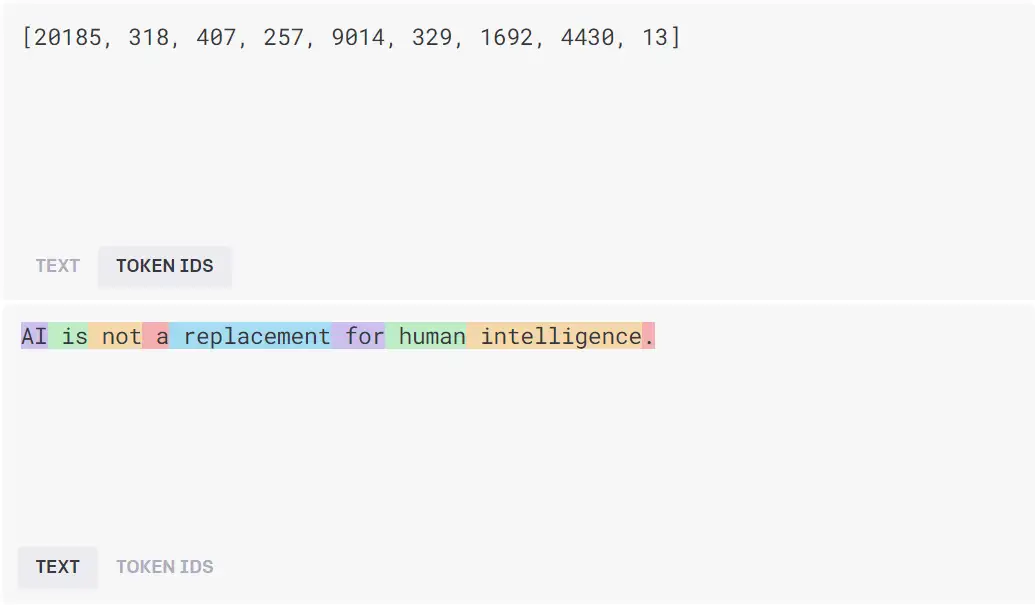
Adding the phrase “let’s think step by step” to your prompt can yield different outcomes.
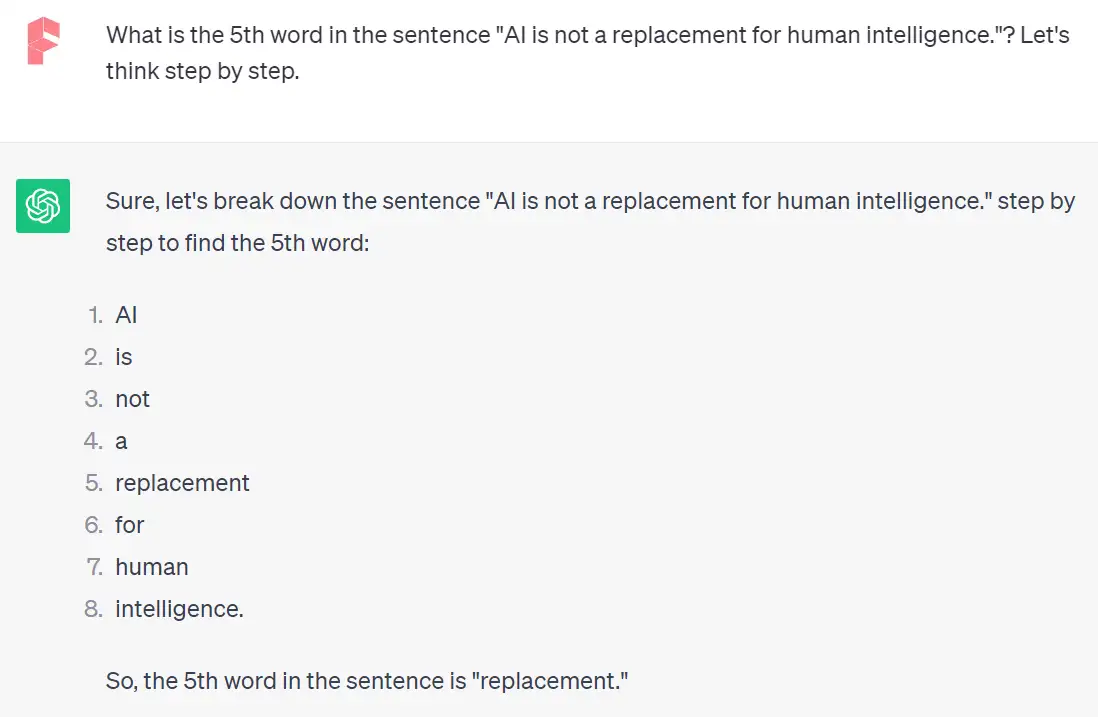
In doing so, ChatGPT will dissect the sentence word by word and provide a more accurate answer. If you encounter a complex question that ChatGPT struggles to answer satisfactorily, consider using this short prompt.
However, it’s crucial to understand that this method is not foolproof. It can sometimes produce unintended consequences.
For example, if you ask ChatGPT to perform a multi-step task in a single query, adding this phrase may cause the model to overcomplicate the problem. This could lead to errors due to excessive division of the task into smaller parts.
2. Walk Me Through Your Reasoning
The phrase “Walk me through your reasoning” prompts ChatGPT to outline its thought process, enhancing user comprehension. This phrase can be particularly useful in various situations:
- In decision-making scenarios where understanding the rationale is essential
- In academic contexts where the reasoning behind a theory or method must be clarified
- During troubleshooting tasks when the steps to a solution need to be understood
- When you’re unfamiliar with a subject and seek to grasp not just the “what,” but also the “why” and “how”
In some cases, this sentence can even help ChatGPT self-correct. For example, I asked ChatGPT the same question as before: “In the sentence ‘AI is not a replacement for human intelligence,’ what is the fifth word?” After receiving an incorrect answer, I followed up with “Walk me through your reasoning.” ChatGPT then corrected its error as it revisited its thought process.
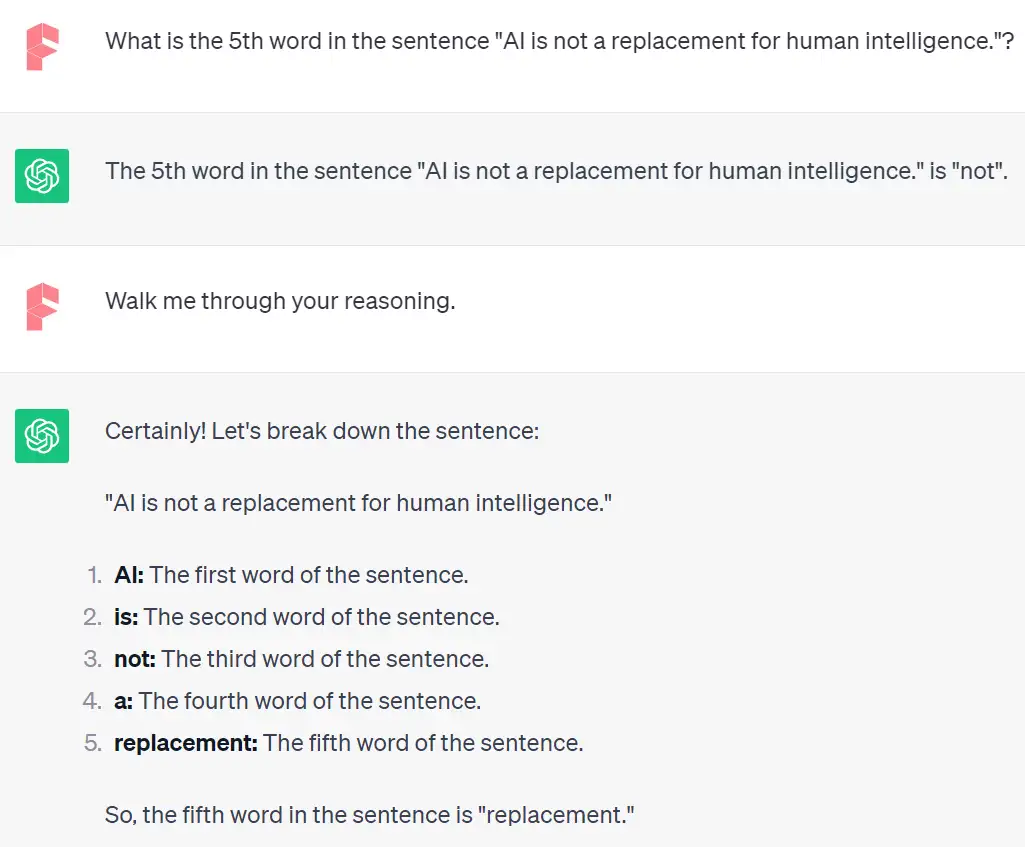
3. Explain This as if I’m Five
Requesting ChatGPT to “Explain this as if I’m five” is a strategy for obtaining simplified, easily digestible answers. This approach can be beneficial in various circumstances:
- For individuals encountering new or complex topics for the first time
- For parents seeking to break down complicated issues for their children
- When quick information is needed due to time constraints
- For professionals who must make technical subjects accessible to a non-technical audience
- To master fundamental concepts without getting lost in complexities
This solution is versatile and quick, making it easy to remember. While other options exist, they aren’t as straightforward. For instance, if you need ChatGPT to explain a technical question in simple terms, you can use the prompt “Explain this as if I’m not tech-savvy” like this.
To illustrate its effectiveness, let’s consider a practical example. I asked ChatGPT to define Chaos Theory in five sentences. Here’s the response:
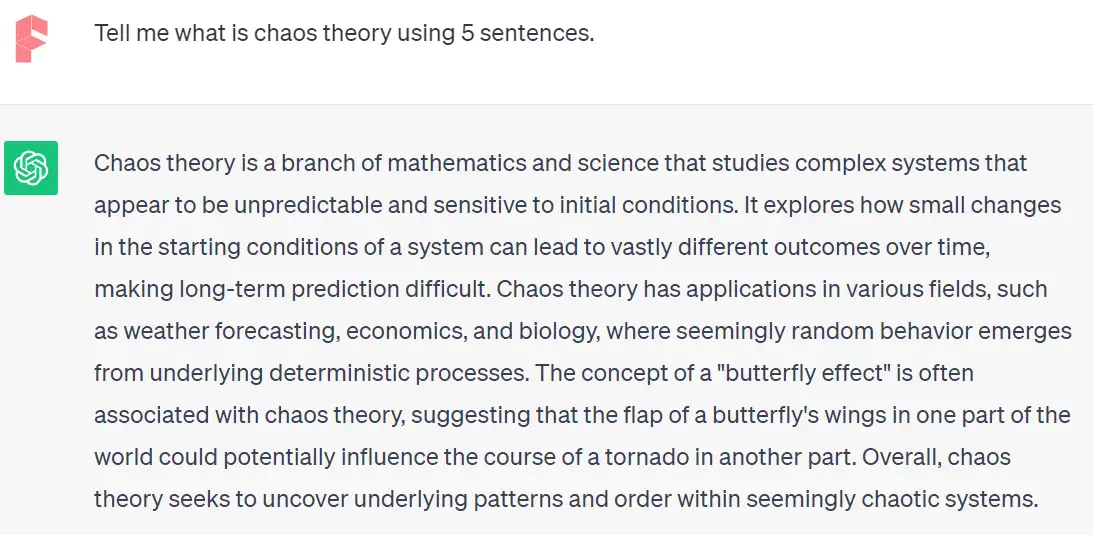
The response, although accurate, was still challenging for a layperson to grasp. However, when I added “Explain this as if I’m five” to the prompt, ChatGPT provided a far more understandable and vivid explanation.
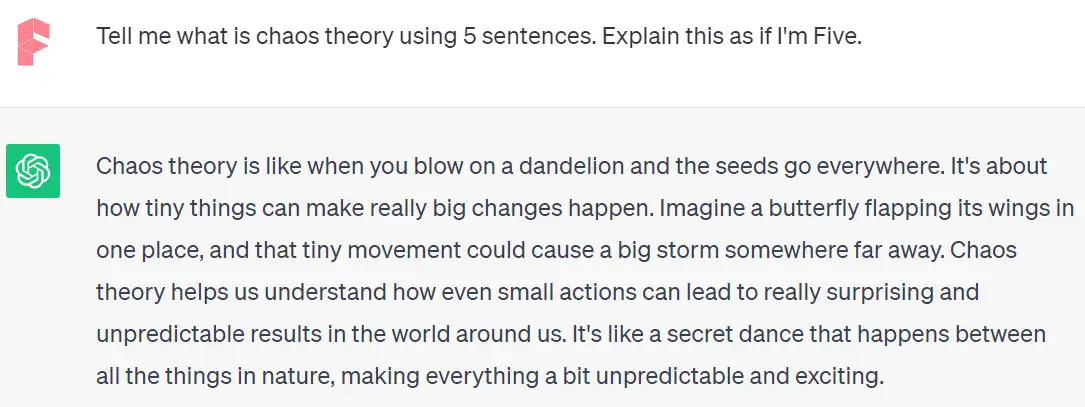
4. Translate This Into a Real-World Example
The prompt “Translate this into a real-world example” encourages ChatGPT to provide concrete examples that illuminate abstract or complex theories. This is particularly helpful in academic settings, business strategy discussions, or any context where grasping the practical implications of an idea is vital.
It’s also useful for individuals who learn best through examples. To continue with the Chaos Theory example, posing this phrase to ChatGPT led to a more grounded explanation.
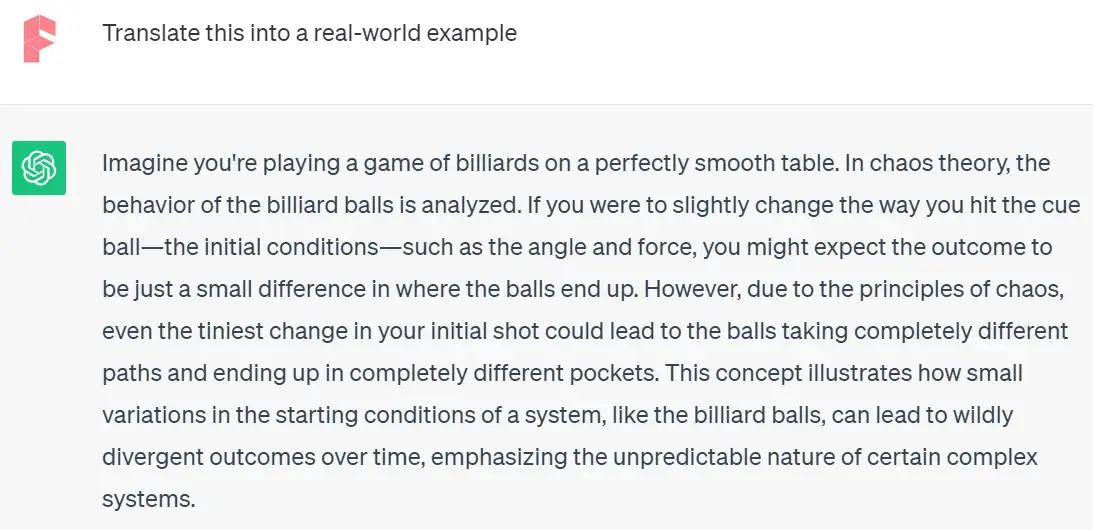
5. Simulate a Conversation About This Topic
The prompt “Simulate a conversation about this topic” allows ChatGPT to stage a dialogue around a specific subject. The resulting simulated conversation offers various perspectives, including potentially contrasting viewpoints.
This interactive approach can facilitate a deeper understanding of the topic, as it engages the user actively instead of relying on passive learning.
For instance, if you anticipate that an interviewer may ask whether you would use ChatGPT to respond to an email from your boss, adding the phrase “Simulate a conversation about this topic” can yield a dynamic discussion. ChatGPT will then simulate a conversation, offering different perspectives on the matter.
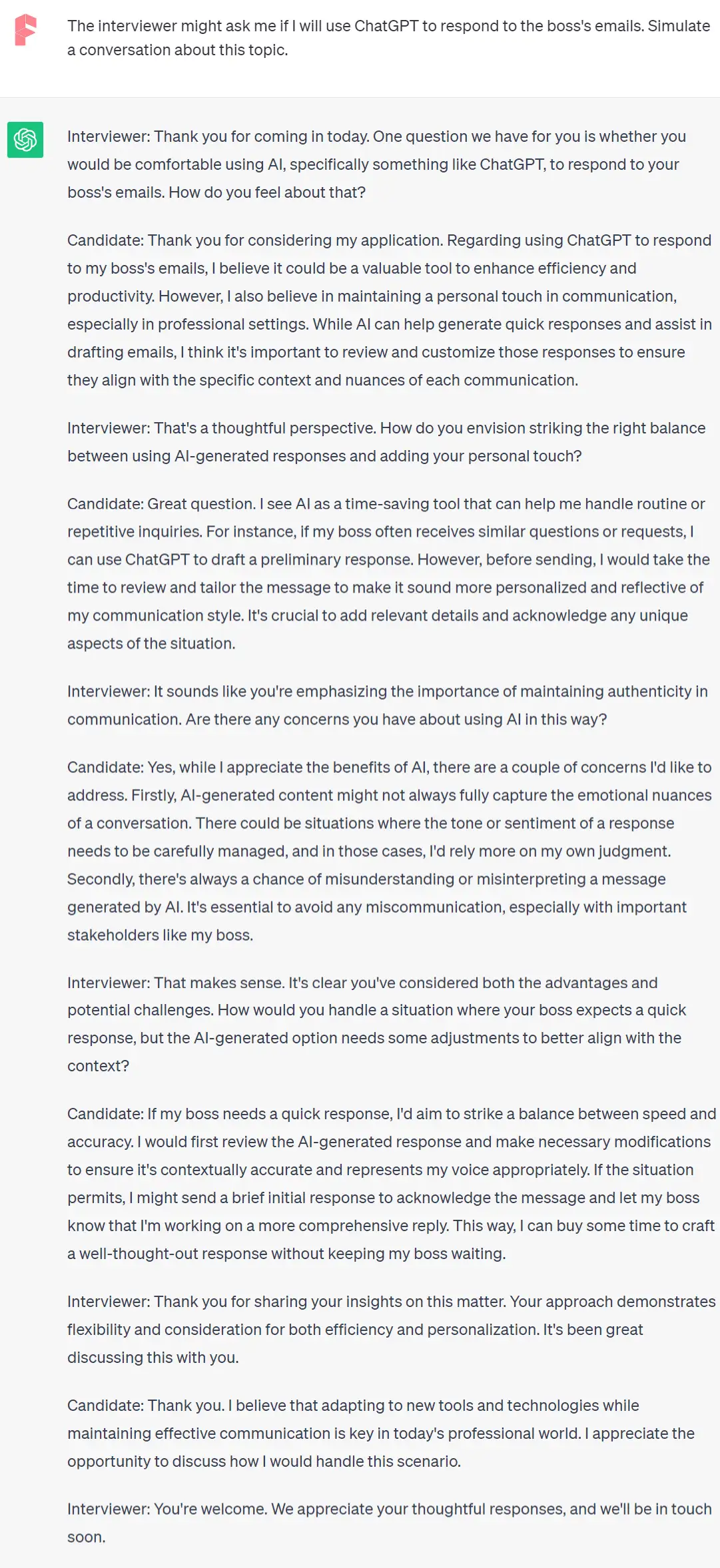
6. List Pros and Cons
The prompt “List Pros and Cons” is straightforward but highly effective. It pushes you to consider multiple facets of an issue, promoting a more balanced and objective viewpoint.
7. Summarize the Key Points
The prompt “Summarize the key points” leverages ChatGPT’s Natural Language Processing (NLP) skills to quickly distill essential information, thereby boosting efficiency.
Various applications, built by software developers around ChatGPT, serve this need. They include tools for summarizing PDFs, web pages, videos, and even books.
For instance, AskYourPDF, a ChatGPT plugin, can summarize an academic paper like “A New Era of Artificial Intelligence in Education: A Multifaceted Revolution.”
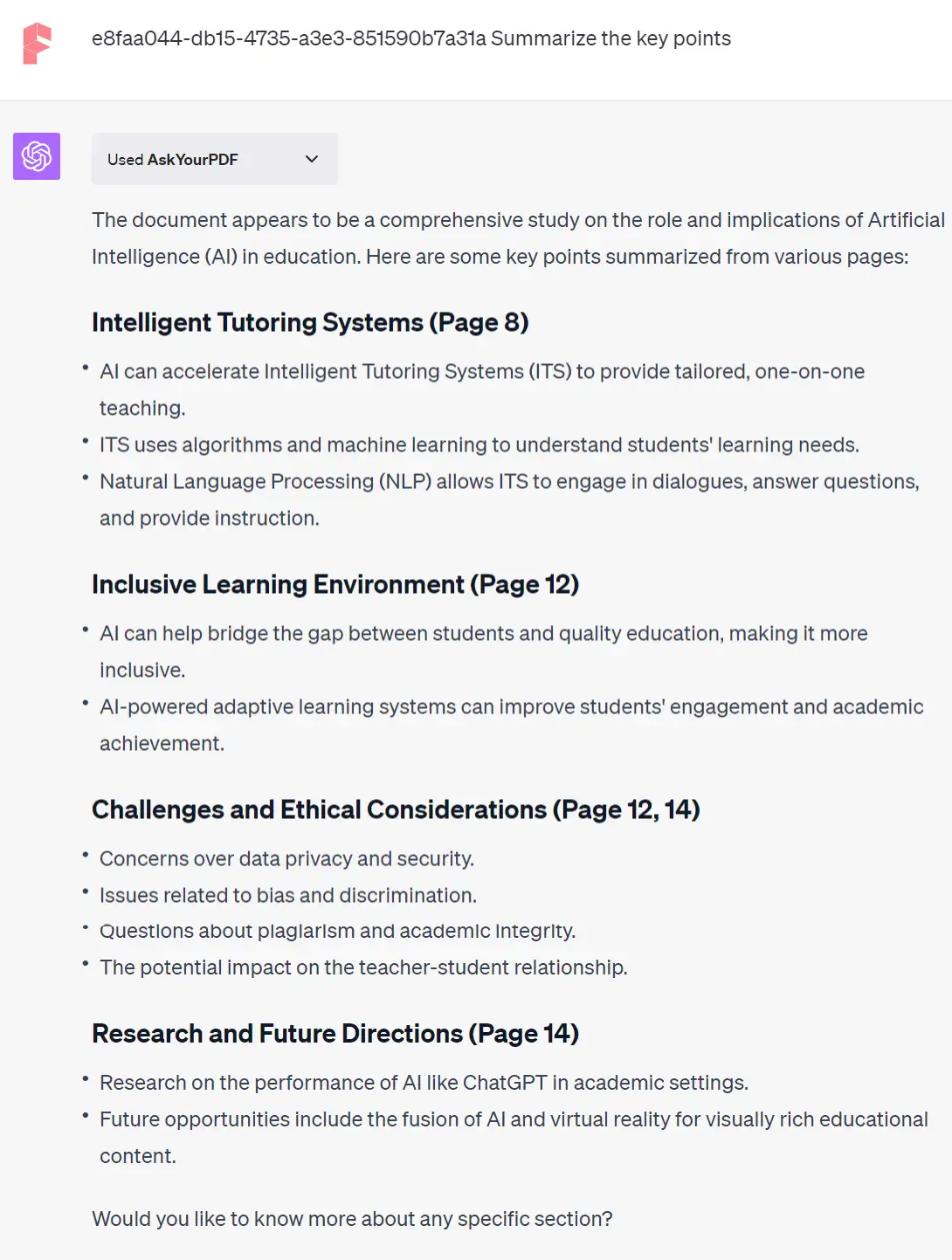
The document ID that appears before the summary is generated by the plugin when the PDF is uploaded.
8. What Are the Facts, Assumptions, and Conclusions?
The prompt “What are the facts, assumptions, and conclusions?” enables ChatGPT to dissect a topic into its foundational elements: facts, assumptions, and conclusions.
This is particularly useful for critical thinking, as it helps clarify the basis of information and exposes any underlying assumptions that may be misleading.
It’s a tool that can be applied across various types of content—academic papers, business reports, news articles, and editorials, to name a few.
By categorizing these elements, we are better positioned to avoid cognitive biases and logical errors. When I applied this prompt to dissect the previous paper, ChatGPT offered a comprehensive breakdown.
Based on the information extracted from the document, here’s a breakdown of facts, assumptions, and conclusions:
Facts:
- Intelligent Tutoring Systems (ITS): AI can accelerate the development of ITS, which provide tailored, one-on-one teaching (Page 8).
- Inclusive Learning: AI can help make education more inclusive by adapting educational content and pedagogical approaches (Page 12).
- Ethical Concerns: There are existing AI ethics initiatives, but none specifically address the issues raised by AI in education (Page 12, 14).
- Data Privacy: AI tools in education collect and process vast quantities of sensitive information, including students’ personal data and academic records (Page 12).
Assumptions:
- Effectiveness of ITS: The document assumes that ITS can effectively emulate the experience of learning from a human tutor (Page 8).
- AI’s Potential: It’s assumed that AI has the potential to revolutionize education, making it more effective and accessible (Page 12).
- Ethical Guidelines: The document assumes that proper ethical guidelines and policies are not yet in place for AI in education (Page 12, 14).
- Human Connection: There’s an assumption that the increased reliance on AI could affect the interpersonal dynamics between teachers and students (Page 14).
Conclusions:
- Need for Ethical Guidelines: There is a need for comprehensive policy and ethical guidelines around AI in education (Page 12, 14).
- Data Security: Robust data protection policies, encryption techniques, and stringent access controls are needed to ensure data privacy and security (Page 12).
- Teacher-Student Relationship: The integration of AI could potentially affect the traditional teacher-student relationship, requiring careful consideration (Page 14).
- Future Directions: As AI technology continues to advance, it will generate new applications in education, including the fusion of AI and virtual reality (Page 14).
Would you like to explore any of these points in more detail?
9. What Information Are We Missing?
The “What information are we missing?” prompt serves multiple purposes.
First, it allows ChatGPT to identify its limitations, highlighting what it doesn’t know. This gives us the opportunity to fill those gaps and achieve a more thorough understanding.
Second, the prompt invites us to be introspective about our own knowledge gaps, which is essential for problem-solving, informed decision-making, and the formation of well-rounded opinions.
When this prompt was applied to the earlier discussed paper, ChatGPT offered a critical and insightful analysis.
Based on the summary and breakdown, there are several areas where information might be missing or could be further elaborated:
- Empirical Evidence: While the document discusses the potential of AI in education, it’s not clear if there are empirical studies that support these claims.
- Stakeholder Opinions: The views of educators, students, and parents on the integration of AI into education are not mentioned.
- Technical Limitations: While the document discusses the capabilities of AI, it doesn’t delve into the technical limitations that might hinder its effective implementation in educational settings.
- Cost and Accessibility: There’s no information on the financial aspects of implementing AI in education, such as the cost of technology and whether it would be accessible to schools with limited resources.
- Legal Framework: While ethical considerations are discussed, there’s no mention of the existing or proposed legal frameworks that would govern the use of AI in education.
- Cultural Context: The document doesn’t discuss how cultural differences might affect the adoption and effectiveness of AI in education globally.
- Long-term Impact: The document talks about future directions but doesn’t discuss the long-term impact of AI on education, both positive and negative.
- Specific Case Studies: Real-world examples or case studies that demonstrate the successful or unsuccessful implementation of AI in educational settings are not provided.
- Methodology: The document appears to be a study, but the methodology used for gathering and analyzing data is not clear.
- Comparative Analysis: A comparison between traditional educational methods and AI-powered methods in terms of effectiveness, cost, and student satisfaction could provide more comprehensive insights.
Would you like to delve into any specific area for more information?
For researchers keen on exploring this area further, ChatGPT’s identified gaps can serve as useful starting points for new investigations.
10. Generate Three Ideas and Rate Them
The prompt “Generate three ideas and rate them” prompts ChatGPT to think creatively while also encouraging critical self-assessment. This approach provides multiple options for you to consider and also evaluates them based on specific criteria.
For example, if someone were contemplating a breakup and wanted to minimize emotional damage, a question along these lines could be submitted to ChatGPT, followed by the prompt. ChatGPT’s response then offers several options, each critically assessed for its potential effectiveness.
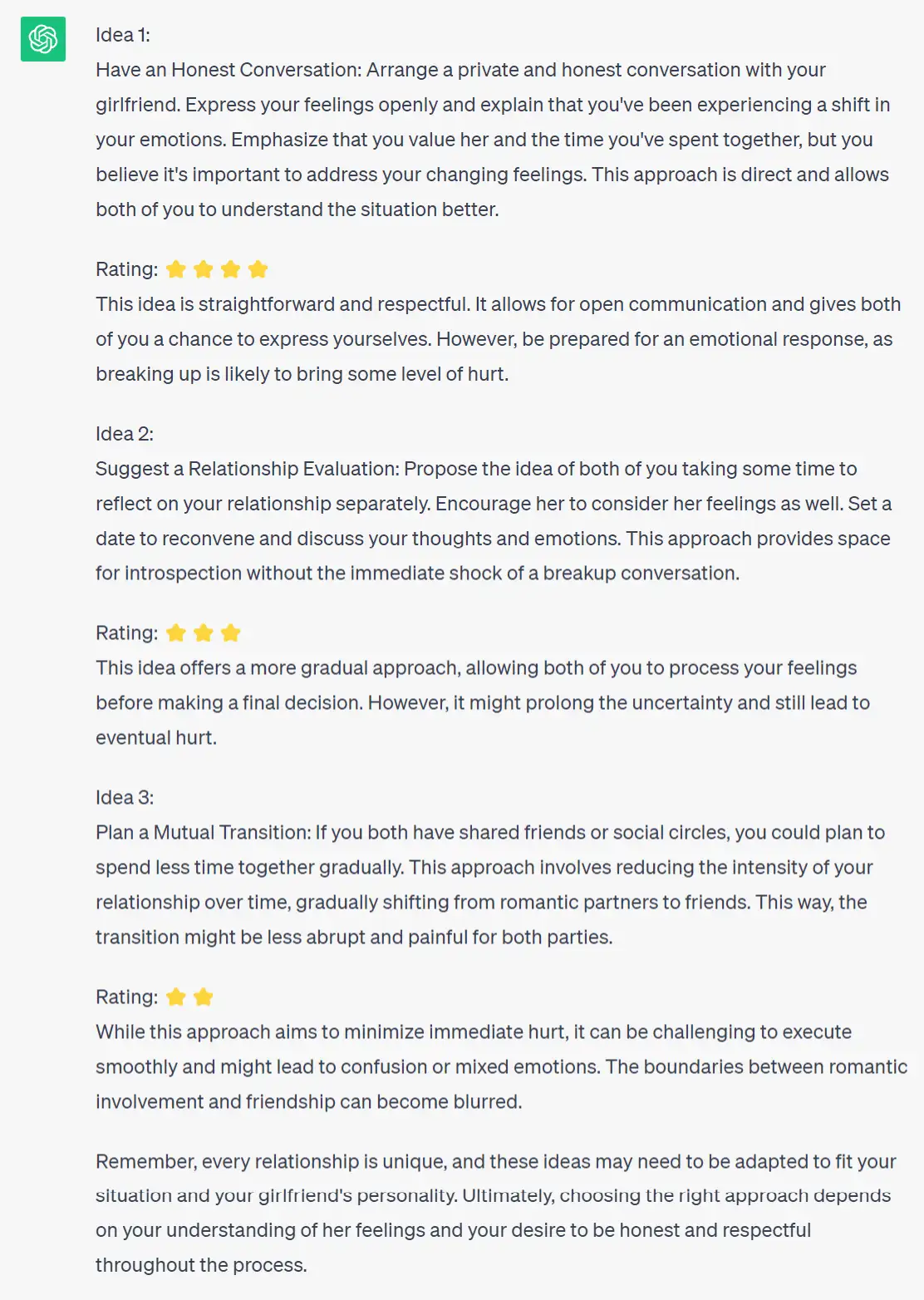
11. Show Alternatives and Justify Your Final Answer
The prompt “Show Alternatives and Justify Your Final Answer” takes the decision-making process a step further. Not only does ChatGPT generate multiple alternatives, but it also provides justification for why one option may be better than the others.
This adds an extra layer of critical evaluation to the problem-solving process, making your decision more informed and robust.
For instance, after considering several approaches for how to sensitively break up with a girlfriend, ChatGPT might show alternatives and then rationalize why one approach might be the most ethical or least harmful.
Alternative 1: Surprise Getaway: Plan a weekend getaway or a special date to spend quality time together. During this time, open up about your feelings and concerns in a gentle and compassionate manner. Express that you’ve noticed a change in your emotions and want to have an honest conversation about the future of the relationship.
Justification: This approach combines a positive experience with a serious conversation. It can create a more relaxed environment, making it easier for both of you to share your feelings. However, there’s a risk that the positive context might be overshadowed by the serious conversation, potentially leading to confusion or mixed emotions.
Alternative 2: Seek Professional Guidance: Suggest attending couples therapy or relationship counseling together. This approach provides a safe space for both of you to express yourselves and navigate the complexities of your emotions with the help of a trained professional.
Justification: Counseling can facilitate healthy communication and help both of you understand your emotions more deeply. It can also provide guidance on whether a breakup is the best course of action. However, suggesting therapy might be misconstrued as a more severe problem, and it could lead to confusion or resistance if your girlfriend doesn’t see the need for it.
Alternative 3: Involve a Trusted Friend: If you have a close mutual friend who can offer support and act as a mediator, consider involving them in the conversation. This person can help convey your feelings and intentions while providing emotional support to both you and your girlfriend.
Justification: Having a mutual friend present can provide comfort during a difficult conversation and potentially soften the impact. However, involving a third party may complicate matters and make it harder for your girlfriend to express herself openly.
Final Suggested Approach: Idea 1 – Have an Honest Conversation
This approach is recommended because it values open communication and respects both your feelings and your girlfriend’s emotions. While all the alternatives have their merits, a direct and honest conversation remains a crucial step in maintaining integrity and ensuring that both parties understand the situation clearly.
Breaking up is difficult, but approaching the situation with honesty and respect is vital. By having an open conversation, you provide your girlfriend with the opportunity to process her feelings, ask questions, and gain closure. It also allows you to maintain your own emotional integrity by not prolonging a relationship that no longer feels genuine.
Ultimately, the best approach depends on your understanding of your girlfriend’s personality, your level of mutual respect, and your commitment to handling the situation with care and compassion.
Summary
The 11 prompts outlined above can serve as useful tools to optimize your interactions with ChatGPT. These prompt strategies aim to make your experience more informative, insightful, and comprehensive.
- Let’s Think Step by Step: For breaking down complex problems.
- Walk me through your reasoning: To understand the logic behind an answer.
- Explain this as if I’m Five: For simplified, easy-to-understand explanations.
- Translate this into a real-world example: To grasp the practical application of abstract concepts.
- Simulate a conversation about this topic: For scenario-based understanding.
- List Pros and Cons: To see both sides of an issue.
- Summarize the key points: For quick and efficient information gathering.
- What are the facts, assumptions, and conclusions?: For a rigorous analysis of information.
- What information are we missing?: To identify gaps in knowledge.
- Generate three ideas and rate them: For creative and critically evaluated options.
- Show Alternatives and Justify Your Final Answer: For a holistic view of a problem, complete with justified solutions.
Whether you’re in academic settings, business discussions, or simply exploring a new concept, these prompts can help facilitate deeper understanding and critical thinking.
Thank you for reading, and if you’re interested in a prompt optimization shortcut, take a look at this article: 2 Ways to Instantly Optimize Your ChatGPT Prompt. To streamline the process of crafting effective prompts, familiarize yourself with this formula: Mastering ChatGPT: The Ultimate Formula for Optimal Responses.






